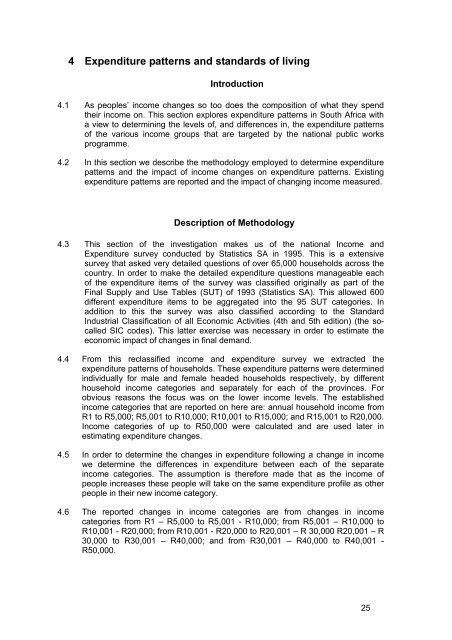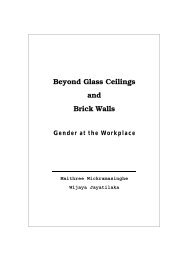SETP No. 14 The Economic Value of Incremental Employment in the ...
SETP No. 14 The Economic Value of Incremental Employment in the ...
SETP No. 14 The Economic Value of Incremental Employment in the ...
Create successful ePaper yourself
Turn your PDF publications into a flip-book with our unique Google optimized e-Paper software.
4 Expenditure patterns and standards <strong>of</strong> liv<strong>in</strong>g<br />
Introduction<br />
4.1 As peoples’ <strong>in</strong>come changes so too does <strong>the</strong> composition <strong>of</strong> what <strong>the</strong>y spend<br />
<strong>the</strong>ir <strong>in</strong>come on. This section explores expenditure patterns <strong>in</strong> South Africa with<br />
a view to determ<strong>in</strong><strong>in</strong>g <strong>the</strong> levels <strong>of</strong>, and differences <strong>in</strong>, <strong>the</strong> expenditure patterns<br />
<strong>of</strong> <strong>the</strong> various <strong>in</strong>come groups that are targeted by <strong>the</strong> national public works<br />
programme.<br />
4.2 In this section we describe <strong>the</strong> methodology employed to determ<strong>in</strong>e expenditure<br />
patterns and <strong>the</strong> impact <strong>of</strong> <strong>in</strong>come changes on expenditure patterns. Exist<strong>in</strong>g<br />
expenditure patterns are reported and <strong>the</strong> impact <strong>of</strong> chang<strong>in</strong>g <strong>in</strong>come measured.<br />
Description <strong>of</strong> Methodology<br />
4.3 This section <strong>of</strong> <strong>the</strong> <strong>in</strong>vestigation makes us <strong>of</strong> <strong>the</strong> national Income and<br />
Expenditure survey conducted by Statistics SA <strong>in</strong> 1995. This is a extensive<br />
survey that asked very detailed questions <strong>of</strong> over 65,000 households across <strong>the</strong><br />
country. In order to make <strong>the</strong> detailed expenditure questions manageable each<br />
<strong>of</strong> <strong>the</strong> expenditure items <strong>of</strong> <strong>the</strong> survey was classified orig<strong>in</strong>ally as part <strong>of</strong> <strong>the</strong><br />
F<strong>in</strong>al Supply and Use Tables (SUT) <strong>of</strong> 1993 (Statistics SA). This allowed 600<br />
different expenditure items to be aggregated <strong>in</strong>to <strong>the</strong> 95 SUT categories. In<br />
addition to this <strong>the</strong> survey was also classified accord<strong>in</strong>g to <strong>the</strong> Standard<br />
Industrial Classification <strong>of</strong> all <strong>Economic</strong> Activities (4th and 5th edition) (<strong>the</strong> socalled<br />
SIC codes). This latter exercise was necessary <strong>in</strong> order to estimate <strong>the</strong><br />
economic impact <strong>of</strong> changes <strong>in</strong> f<strong>in</strong>al demand.<br />
4.4 From this reclassified <strong>in</strong>come and expenditure survey we extracted <strong>the</strong><br />
expenditure patterns <strong>of</strong> households. <strong>The</strong>se expenditure patterns were determ<strong>in</strong>ed<br />
<strong>in</strong>dividually for male and female headed households respectively, by different<br />
household <strong>in</strong>come categories and separately for each <strong>of</strong> <strong>the</strong> prov<strong>in</strong>ces. For<br />
obvious reasons <strong>the</strong> focus was on <strong>the</strong> lower <strong>in</strong>come levels. <strong>The</strong> established<br />
<strong>in</strong>come categories that are reported on here are: annual household <strong>in</strong>come from<br />
R1 to R5,000; R5,001 to R10,000; R10,001 to R15,000; and R15,001 to R20,000.<br />
Income categories <strong>of</strong> up to R50,000 were calculated and are used later <strong>in</strong><br />
estimat<strong>in</strong>g expenditure changes.<br />
4.5 In order to determ<strong>in</strong>e <strong>the</strong> changes <strong>in</strong> expenditure follow<strong>in</strong>g a change <strong>in</strong> <strong>in</strong>come<br />
we determ<strong>in</strong>e <strong>the</strong> differences <strong>in</strong> expenditure between each <strong>of</strong> <strong>the</strong> separate<br />
<strong>in</strong>come categories. <strong>The</strong> assumption is <strong>the</strong>refore made that as <strong>the</strong> <strong>in</strong>come <strong>of</strong><br />
people <strong>in</strong>creases <strong>the</strong>se people will take on <strong>the</strong> same expenditure pr<strong>of</strong>ile as o<strong>the</strong>r<br />
people <strong>in</strong> <strong>the</strong>ir new <strong>in</strong>come category.<br />
4.6 <strong>The</strong> reported changes <strong>in</strong> <strong>in</strong>come categories are from changes <strong>in</strong> <strong>in</strong>come<br />
categories from R1 – R5,000 to R5,001 - R10,000; from R5,001 – R10,000 to<br />
R10,001 - R20,000; from R10,001 - R20,000 to R20,001 – R 30,000 R20,001 – R<br />
30,000 to R30,001 – R40,000; and from R30,001 – R40,000 to R40,001 -<br />
R50,000.<br />
25
















